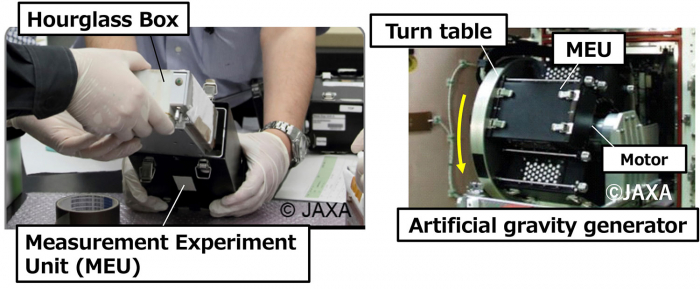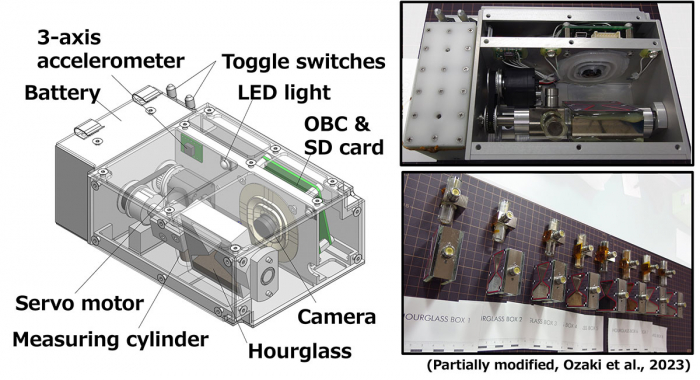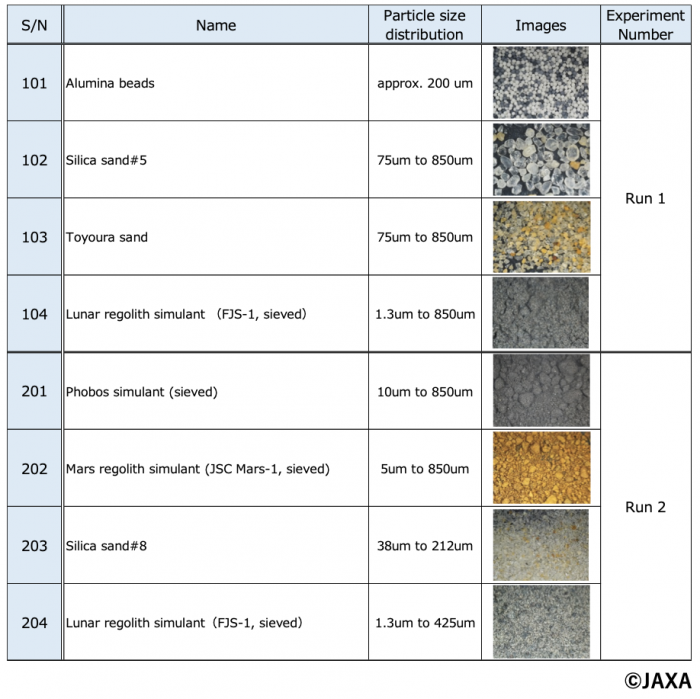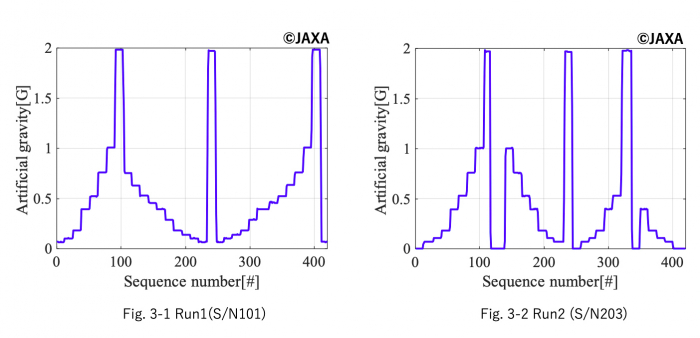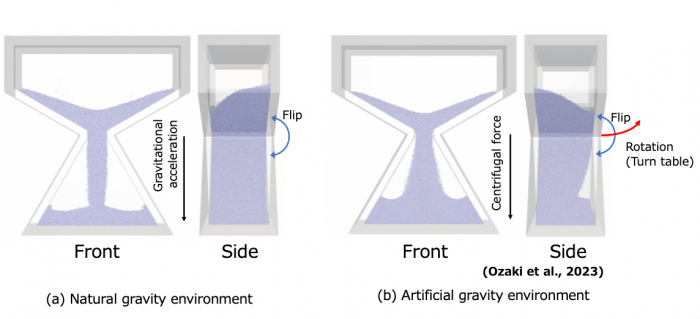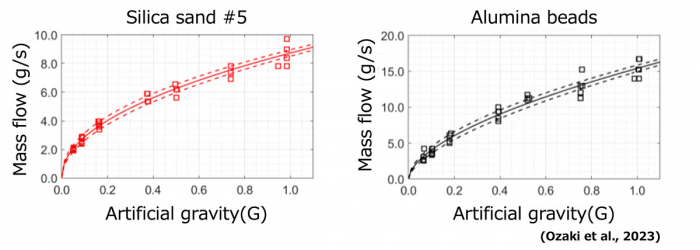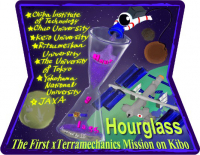Experiment to explore how sand on different planets falls by replicating the gravitational environment of various celestial bodies onboard the ISS (Hourglass)
* (ISS: International Space Station)
The surface layer of solid planets (planets that are primarily composed of rock, such as the terrestrial planets) is covered with fine sand (regolith). Predicting how spacecraft will be affected by a planet's surface sand, and how the spacecraft will in turn affect the sand through interaction, is necessary when designing spacecraft to explore unknown celestial bodies. This interaction is an important factor in estimating the specific performance of various components of the spacecraft system, for example, how much area the landing pad must cover to prevent being buried in the surface layer of the celestial body, or how efficiently a robot can run across the surface which dictates the required solar cell size and battery capacity.
Understanding the behavior of granular media such as regolith should be answerable through experiments, but factors such as gravity, atmospheric pressure, temperature, and various environments differ between ground on Earth and the surface layer of celestial bodies. This makes it difficult to reproduce conditions accurately in ground experiments. One of the most important factors is that the gravitational force acts as the dominant acting force on the regolith particles and their aggregates on the Earth, but in low gravity, different forces (intermolecular force, electrostatic force, etc.) that depend on the particle size become dominant. It is difficult to predict the overall behavior and interaction while performing an analysis with limited acting forces.
Therefore, the characteristics of the celestial surface layer can only be understood by going to the actual site and touching the surface, but we cannot wait until then for the development of the spacecraft. To tackle this issue, the Hourglass mission was developed to study the behavior of different granular media in low gravity environments onboard the International Space Station. The goal was to acquire the set of parameters that can be used in analysis to reduce the required resources needed to realize a spacecraft design.
Numerical simulations have long been used to verify the design of landers and rovers, which are indispensable for lunar and planetary exploration, as well as for the preliminary validation of various missions. However, the gravity of the celestial surface layer at the landing target for the spacecraft is less than 1G, making it difficult to confirm these results in ground experiments on Earth. While parabolic flight in an airplane and free fall within a drop tower are often used as test environments for low gravity, it difficult to reproduce a stable and long-term low gravity environment with these methods, and therefore challenging to obtain sufficient measurement results to verify the gravitational dependence of the flow behavior of the surface granular media.
This has meant that current spacecraft designs are limited to using parameters acquired by predicting the characteristics of the surface layer from remote observation and knowledge about the formation of celestial bodies, and the uncertainty for an analysis is large. There are many records from previous spacecraft activities on the surface of celestial bodies, and observational results of the macroscopic interaction forces. However, to observe the behavior of regolith particles, it is necessary to continuously capture video while tracking several tens of micron-sized floating regolith particles, which is difficult. If a stable, long-term low-gravity environment can be established in a closed space and the behavior of small regolith particles can be recorded in a video, then a resulting parameter set that can be used to form the basis of future calculations can be obtained.
With this in mind, the Hourglass mission was developed to conduct flow experiments using an hourglass-shaped specimen container holding sand from Earth and simulated regolith. The set-up was placed in an artificial gravity environment of less than 1G generated using the centrifugal force created by the turntable-type cell culture experimental equipment (CBEF: Centrifuge-equipped Biological Experiment Facility) installed in the Kibo module of the International Space Station (ISS).
For the upcoming Martian Moons eXploration (MMX) mission, the plan is to land the spacecraft on a small celestial body and remain there for a prolonged period of time. There is therefore a risk that the mission may not be able to continue due to the spacecraft overturning or becoming buried depending on the interaction between the spacecraft and regolith layer. Researchers have therefore been discussing from an early stage in the mission how to determine the characteristics of the surface and regolith of small celestial bodies. The idea to conduct tests using granular media with the CBEF was proposed amongst the MMX landing gear study team that included university researchers, and it was decided to implement this plan after consultation with the JAXA human spaceflight technology directorate.
CBEF has been previously used in biological experiments, and can stably supply an arbitrary low-gravity environment over a long time. The device was therefore considered suitable for providing a suitable gravity environment for specifying granular flow characteristics. This is a new approach in which experiments in the near-Earth space environment are used for preliminary demonstration of landing exploration in deep space.
The gravitational environments tested ranged from 0.06G, at the lower limit of 1 rpm that CBEF can achieve, to 2G that can be reproduced on the ground. The number of levels was based on the operating time of the experimental equipment and the number of trials to be performed, and included the gravity of the Earth, Moon, and Mars, which are the main targets for landing exploration. In addition, eight types of granular media were selected that simulated the regolith of Earth's moon, Mars, and the Martian moons, silica sand which is ground typical sand and often used by researchers, and alumina beads with a range of particle sizes that can easily be compared with the calculation results of the Distinct Element Method (DEM).
An hourglass-shaped experimental device (Hourglass Box) in which the granular media were enclosed in a vacuum state was placed in the box-shaped Measurement Experiment Unit (MEU) and four of these were mounted on the CBEF turntable (artificial gravity generator) at every 90 degrees. The centrifugal force was generated to create the artificial gravity by controlling the rotation speed (Fig. 1).
Fig.1 Installing the Hourglass Box on the turntable inside the CBEF (The photo is from the fit check)
This allowed the granular media to which centrifugal force was applied within the microgravity environment in the ISS to be placed in an artificial low-gravity environment. The hourglass-shaped specimen was repeatedly inverted (turned over) with respect to the centrifugal force direction while maintaining this state. The rotational speed of the turntable was controlled to correspond to various artificial gravity levels, and the camera captured the granular media flowing and falling in the direction of the artificial gravity.
The outline and internal configuration of the Hourglass Box are shown in Fig. 2. The Hourglass Box is equipped with hourglass-type and female cylinder-type containers containing sample granular media, a camera for imaging the behavior of granular media (continuous still images), an acceleration sensor for artificial gravity measurement, and a servomotor that inverts a set of containers at regular intervals. The Hourglass Box was powered by primary batteries.
Fig.2 Internal equipment configuration of Hourglass Box
In this mission, eight types of granular media were selected as experimental samples (see Table 1). The alumina beads shown in Table #1 were selected as a comparison target for other granular media, with a particle shape that was almost spherical and particle size distribution width that was very small. The characteristics of Tohoku silica sand (#2, #7) have been reported in many previous studies, and were selected as a typical example of sand on the Earth. Toyoura sand (#3) is also used as standard sand in the field of geotechnical engineering like Tohoku silica sand, and its soil characteristics have been elucidated. The quality of Toyoura sand is constant, and the sand is suitable for comparison between this experiment and conventional knowledge. In addition, simulated regolith of Earth's moon, the Martian moon, and Mars, which are expected to be future exploration destinations, were selected as #4, 5, 6, and 8, respectively.
Table.1 Experimental samples, encapsulated experimental equipment, and corresponding experiments
After the astronauts turned on the two toggle switches on the Hourglass Box and attached them to the CBEF, the sequence ran automatically, and the turntable was rotated accordingly by direct operation from the ground station. A centrifugal force equivalent to artificial gravity shown in Fig. 3-1 and 3-2 (0.06~2G) was generated on the turntable.
Fig.3 Experimental artificial gravity values (Moon: 0.17G, Mars: 0.38G, Earth: 1.0G)
The Hourglass Box was designed to operate for 8 hours, with a waiting period for the first hour for incorporation into the CBEF, and the hourglass was flipped 420 times in the next 7 hours. The obtained data was stored on an SD card inside the Hourglass Box, which the astronauts read into a PC while in orbit. All the data contents were transferred to the ground via down-link communication between the ISS and the ground station, and Fig. 4 shows an image of each test sample at the end of flow.
Fig.4 Granular media at the end of flow (0.06G)
In order to correctly interpret the experimental results, numerical simulations were first conducted to investigate the difference in flow behavior between natural gravity and artificial gravity environments. For the numerical analysis, we used the DEM (Distinct Element Method) that has been proven in the fields of powder engineering and soil mechanics. The numerical analysis results for the alumina beads under natural gravity and artificial gravity environments are shown in Fig. 5. As a result of the analysis, it was found that the accumulation in the upper part of the discharge port, which is related to the flow rate of the powder, agreed well between the natural gravity environment and the artificial gravity environment. On the other hand, when a particle is ejected in the artificial gravity environment, it becomes weightless (microgravity on the ISS) and exhibits uniform velocity motion, whereas in a natural gravity environment, it exhibits uniform acceleration motion. Therefore, there was a difference in speed by the time the bottom surface was reached. In addition, in the artificial gravity environment, the particles are affected by the Coriolis force during the fall as they transition from the rotating system to the inertial frame. However, within the range of the drop distance of this experimental device, it was found that these effects were smaller than those on the flow velocity exerted by gravitational conditions. By verification through these numerical simulations, it was confirmed that this experiment could sufficiently reproduced the gravitational dependence of granular flow in natural gravity.
Fig. 5 Flow simulation in low gravity environment using the individual element method (0.1G)
Next, by regression analysis of the measurement results of the flow velocity during the experiments onboard the ISS, it was clarified that the gravitational dependence of the flow velocity follows the well-known Beverloo law even under low gravity conditions. In addition, we demonstrated that the flow velocity under low gravity conditions, which had been limited to the hypothesis until now, is proportional to the square root (√G) of the magnitude of gravity depending on the type of sand (Fig. 6). Furthermore, the results of regression analysis suggest that the bulk density of sand decreases with gravity.
Fig.6 Gravity dependence of sand flow velocity (regression analysis results)
As a result of the Hourglass mission, more than 3000 continuous image data sets were acquired to observe the behavior and accumulation state of 8 types of granular media (simulated regolith and natural sand) under a controlled simulated gravity environment (10 levels of gravitational strength) in a confined space.
Based on this data and the results of this study, the characteristics of the gravity-dependent flow and bulk density of sand can be used as a basis for a mechanical model and parameter set necessary for predicting the interaction between machines and regolith under low gravity. For example, it will be possible to create a good initial ground state for a celestial body that is the target for future exploration, and contribute to improving the accuracy of numerical analysis of the ground reaction force to the lander and the rover's traversability, which strongly depends on the magnitude of gravity in which the regolith is placed. By proceeding with multi-level parametric studies, we can break away from designs that include many margins associated with the worst-case possible case, and improve the efficiency and optimal designs with more limited parameters. As a result, this study will improve the reliability of design verification, reduce the weight of the related subsystems, and shorten the development period, and will be one of the stepping stones for high-frequency exploration activities in Japan.
The behavior of the granular media in low gravity, which has never been seen before at the particle level, will also attract interest from non-researchers, providing non-speculative answers to questions such as "How long would it take to drain the sand if you flipped an hourglass on the Moon?". The limitation of numerical modeling is that it can only consider the acting force that has been taken into account, so the extent to which forces other than gravity work in low gravity, and whether the structure of the model itself changes when gravity is removed are now gradually becoming clear through further analysis of the data acquired through the Hourglass mission. The Hourglass data is also likely to contribute to the identification of planet formation processes and the future of spacecraft design.
Terminologies
1. Hourglass mission:The mission examined the relationship between gravity and the behavior of granular media such as regolith that covers the surface of planets and small bodies with mounting an experimental device (Hourglass Box) on CBEF of the "Kibo" module of the International Space Station.
URL: https://humans-in-space.jaxa.jp/en/biz-lab/experiment/theme/detail/000816.html
2. CBEF (Cell Biology Experiment Facility):The centrifugal function in the device can generate artificial gravity, simulating the gravitational environment of the lunar surface and Mars.
URL : https://humans-in-space.jaxa.jp/en/biz-lab/experiment/facility/pm/cbef/
3. MEU (Measurement Experiment Unit):A small box for attaching experimental specimens to the CBEF.
URL : https://humans-in-space.jaxa.jp/en/biz-lab/experiment/facility/pm/beu/
4. DEM (Distinct Element Method):A numerical analysis method that models an analyte as a collection of individual particles and analyzes their motion at each time, taking into account the contact and slippage between particles or between particles and solids.
5. Beverloo law:A law proposed by Beverloo et al. that describes the mass flow rate (mass per unit time) of granular media flowing out of outlets such as silos and hourglasses.
Reference: J. Chem. Eng. Sci. 15, 260-296 (1961).
Journal paper information
Full title of the paper: Granular flow experiment using artificial gravity generator at International Space Station
Author(s): S. Ozaki* 1,G. Ishigami* 2,M. Otsuki* 3,H. Miyamoto 4,K. Wada 5,Y. Watanabe 1,T. Nishino 1,H. Kojima 2,K. Soda 2,Y. Nakao 2,M. Sutoh 6,T. Maeda 7,and T. Kobayashi 8
(*corresponding authors)
1. Yokohama National University,2. Keio University,3. Japan Aerospace Exploration Agency (ISAS),4. The University of Tokyo,5. Chiba Institute of Technology,6. Japan Aerospace Exploration Agency (Innovation Hub Center),7. Tokyo University of Agriculture and Technology,8. Ritsumeikan University
Journal title: npj Microgravity
Publish date: 08 Augst 2023 JST
DOI: 10.1038/s41526-023-00308-w
Videos of experiments and numerical simulations: https:/osf.io/3zcm2/

